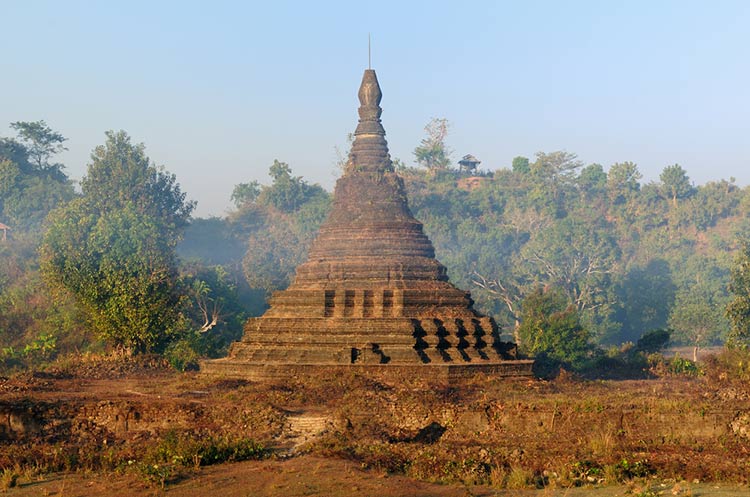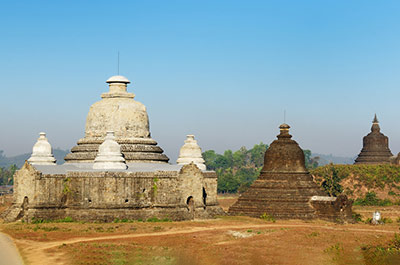
Mrauk U
Ancient capital of the powerful Mrauk U empire
Mrauk U is a little known archaeological site in Western Burma. In the beautiful hilly landscape of the Rakhine state hundreds of ancient temples and pagodas, many of which are well preserved remain of the powerful empire that once flourished here.
The site used to be the capital of the Mrauk U Kingdom, a powerful empire that existed from 1430 until 1785.
Today Mrauk U is a small town where the centuries old monuments form the backdrop for every day life of local people. Goat herders tend to their animals, farmers work their fields and women fetch water from the wells between the ancient temples and pagodas. Often the area is foggy, especially during the early morning hours, which creates a mystical atmosphere.
Mrauk U is a site that receives very few visitors compared to sites as Angkor in Cambodia or Ayutthaya in Thailand. Recently the Rakhine area has been the scene of unrest and the area has been temporarily closed to foreign visitors. Before travelling to the area, make sure there are no travel restrictions. Information can be obtained from the Burmese embassy in your home country.
Mrauk U archaeological zone
Centered around the town of Mrauk U is the Mrauk U archaeological zone, an area of 7 km2 where hundreds of temples and pagodas were built between the 15th and 18th century. The capital of the Kingdom was protected by 35 kilometer long walls and moats; at the center of the city was the Royal Palace. While practically nothing remains of the palace, some remnants of the walls and city gates can still be seen today.
Impressive bunker like temples like the Htukkanthein and the Shite-Thaung built from stone and brick and surrounded by thick solid walls were constructed. As these temples were often built on top of hills, allowing people good views of the surrounding area and possible approaching enemies, they probably served as places of refuge during times of war.
In 1996 excavations and restoration works started. While a number of monuments have been restored to their original glory, many are still buried under soil and thick vegetation. Visitors to the zone are required to buy a Mrauk U archaeological zone pass at US$ 10. The fee as well as a 3,000 Kyat light fee is collected at several places including the Shite-Thaung temple.
History of Mrauk U
The Mrauk U Kingdom was founded in 1430 by King Min Saw Mon. At the height of its power the Kingdom ruled over much of present day Bangladesh and Burma, for a large part thanks to its large naval fleet. The Mrauk U Kings would have Japanese samurai fighters as body guards.
Mrauk U was well protected by a defense system consisting of defensive walls and the clever use of waterways. A system of moats, canals and man made lakes allowed them to flood the area in case of invasion. As the empire grew more wealthy, the King and rich inhabitants built temples and pagodas to gain religious merit.
Mrauk U was an important port in the 16th and 17th centuries. Ships from many countries frequented the city to do trade. Although about 70 kilometers from the sea, Mrauk U could at the time be reached by the largest sea going ships from the Bay of Bengal.
In 1785 the Mrauk U Kingdom was besieged by King Bodawpaya of the Konbaung dynasty. Burma’s most highly revered Buddha image, the Mahamuni image which was cast in Dhanyawadi near Mrauk U was seized by Bodawpaya and taken back to Amarapura. The image is now enshrined in the Mahamuni Pagoda in Mandalay.
Royal Palace
The remains of the Royal Palace are found in the center of town, just East of the market. Very little is left of the teak wood building that once stood here; only parts of the walls remain. Located on the grounds is the Archaeology Museum which opens from 9 am until 4.30 pm, admission is US$ 5 per person.
Temples and pagodas of Mrauk U
Over a period of more than 350 years countless temples and pagodas were built. Some of the best known are:
- Htukkanthein temple
- Koe-Thaung temple (shrine of the 90,000 images of the Buddha)
- Le-myet-hna temple (four faced pagoda)
- Ratana-Pon pagoda
- Shite-Thaung temple (temple of the 80,000 images of the Buddha)
- Laungbanpyauk pagoda (colored tile pagoda)
- Mahabodhi Shwegu temple
How to get to Mrauk U
Mrauk U is located between the Kaladan and Lay Myo rivers in Rakhine state in the Western part of Burma, near the Bay of Bengal. The journey to Mrauk U is an adventure and attraction in itself. The only way to get there is a combination of flight and river boat.
The first leg of the trip is a domestic flight to Sittwe, a town on the Bay of Bengal. Several Burmese airlines offer flights. Air Mandalay offers flights from Yangon to Sittwe that take 1 hour and 20 minutes. Air Bagan flies five times weekly from Yangon to Sittwe; flights take 1 hour and 20 minutes. Asian Wings serves Sittwe from Yangon. For more information, visit their website.
The second leg is a pleasant boat trip from Sittwe to Mrauk on the Kaladan river and tributary streams, a distance of about 65 kilometers. The large public ferry takes about 7 to 8 hours. Along the way it stops regularly to take more people on board. The fare is 10,000 Kyat or about US$ 12 one way. A little faster is a small private boat. Prices range between US$ 80 and 150 for a round trip. Usually the boat driver will wait in Mrauk U for the return trip to Sittwe. Prices therefore depend on the number of nights spend there.
Getting around
Several hotels organize tours by Jeep or horse cart around the archaeological zone. Alternatively, hire a horse cart at about US$ 10 per day, a Jeep at US$ 25 per day or a bicycle at 2,000 Kyat a day.

